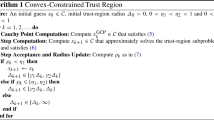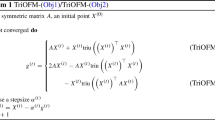Abstract
We present a novel method for approximately equilibrating a matrix using only multiplication by the matrix and its transpose. Our method is based on convex optimization and projected stochastic gradient descent, using an unbiased estimate of a gradient obtained by a randomized method. Our method provably converges in expectation and empirically gets good results with a small number of iterations. We show how the method can be applied as a preconditioner for matrix-free iterative algorithms, substantially reducing the iterations required to reach a given level of precision. We also derive a novel connection between equilibration and condition number, showing that equilibration minimizes an upper bound on the condition number over all choices of row and column scalings.




Similar content being viewed by others
References
Hwang, I., Balakrishnan, H., Roy, K., Shin, J., Guibas, L., Tomlin, C.: Multiple-target tracking and identity management. In: Proceedings of IEEE Sensors, pp. 36–41 (2003)
Knight, P.: The Sinkhorn–Knopp algorithm: convergence and applications. SIAM J. Matrix Anal. Appl. 30(1), 261–275 (2008)
Schneider, M., Zenios, S.: A comparative study of algorithms for matrix balancing. Oper. Res. 38(3), 439–455 (1990)
Bradley, A.: Algorithms for the equilibration of matrices and their application to limited-memory Quasi-Newton methods. Ph.D. thesis, Stanford University (2010)
Nocedal, J., Wright, S.: Numerical Optimization. Springer, New York (2000)
Takapoui, R., Javadi, H.: Preconditioning via diagonal scaling. EE364b: Convex Optimization II Class Project (2014). http://stanford.edu/class/ee364b/projects/2014projects/reports/takapoui_javadi_report.pdf
Giselsson, P., Boyd, S.: Diagonal scaling in Douglas–Rachford splitting and ADMM. In: Proceedings of the IEEE Conference on Decision and Control, pp. 5033–5039 (2014)
Kelley, C.: Iterative Methods for Linear and Nonlinear Equations. Society for Industrial and Applied Mathematics, Philadelphia (1995)
Greenbaum, A.: Iterative Methods for Solving Linear Systems. Society for Industrial and Applied Mathematics, Philadelphia (1997)
Pock, T., Chambolle, A.: Diagonal preconditioning for first order primal-dual algorithms in convex optimization. In: Proceedings of the IEEE International Conference on Computer Vision, pp. 1762–1769 (2011)
Giselsson, P., Boyd, S.: Metric selection in fast dual forward-backward splitting. Automatica 62, 1–10 (2015)
Sluis, A.: Condition numbers and equilibration of matrices. Numer. Math. 14(1), 14–23 (1969)
Sinkhorn, R., Knopp, P.: Concerning nonnegative matrices and doubly stochastic matrices. Pac. J. Math. 21(2), 343–348 (1967)
Ruiz, D.: A scaling algorithm to equilibrate both rows and columns norms in matrices. Technical report, Rutherford Appleton Lab., Oxon, UK, RAL-TR-2001-034 (2001)
Hestenes, M., Stiefel, E.: Methods of conjugate gradients for solving linear systems. J. Res. Natl. Bur. Stand. 49(6), 409–436 (1952)
Paige, C., Saunders, M.: LSQR: an algorithm for sparse linear equations and sparse least squares. ACM Trans. Math. Softw. 8(1), 43–71 (1982)
Chambolle, A., Pock, T.: A first-order primal-dual algorithm for convex problems with applications to imaging. J. Math. Imaging Vis. 40(1), 120–145 (2011)
Fougner, C., Boyd, S.: Parameter selection and pre-conditioning for a graph form solver. Preprint (2015). arXiv:1503.08366v1
Balakrishnan, H., Hwang, I., Tomlin, C.: Polynomial approximation algorithms for belief matrix maintenance in identity management. In: Proceedings of the IEEE Conference on Decision and Control, pp. 4874–4879 (2004)
Boyd, S., Vandenberghe, L.: Convex Optimization. Cambridge University Press, Cambridge (2004)
Corless, R., Gonnet, G., Hare, D., Jeffrey, D., Knuth, D.: On the Lambert \(W\) function. Adv. Comput. Math. 5(1), 329–359 (1996)
Hoorfar, A., Hassani, M.: Inequalities on the Lambert \(W\) function and hyperpower function. J. Inequal. Pure Appl. Math. 9, 1–5 (2008)
Bekas, C., Kokiopoulou, E., Saad, Y.: An estimator for the diagonal of a matrix. Appl. Numer. Math. 57(11–12), 1214–1229 (2007)
Hutchinson, M.: A stochastic estimator of the trace of the influence matrix for Laplacian smoothing splines. Commun. Stat. Simul. Comput. 19(2), 433–450 (1990)
Lacoste-Julien, S., Schmidt, M., Bach, F.: A simpler approach to obtaining an \({O}(1/t)\) convergence rate for the projected stochastic subgradient method. Preprint (2002). arXiv:1212.2002v2
Bubeck, S.: Convex optimization: algorithms and complexity. Found. Trends Mach. Learn. 8(3–4), 231–357 (2015)
Pock, T., Cremers, D., Bischof, H., Chambolle, A.: An algorithm for minimizing the Mumford–Shah functional. In: Proceedings of the IEEE International Conference on Computer Vision, pp. 1133–1140 (2009)
Friedman, J., Hastie, T., Tibshirani, R.: The Elements of Statistical Learning, Springer Series in Statistics, vol. 1. Springer, New York (2001)
Diamond, S., Boyd, S.: CVXPY: a Python-embedded modeling language for convex optimization. J. Mach. Learn. Res. 17(83), 1–5 (2016)
Gurobi Optimization, Inc.: Gurobi optimizer reference manual (2015). http://www.gurobi.com
Lehoucq, R., Sorensen, D.: Deflation techniques for an implicitly restarted Arnoldi iteration. SIAM J. Matrix Anal. Appl. 17(4), 789–821 (1996)
O’Donoghue, B., Chu, E., Parikh, N., Boyd, S.: Conic optimization via operator splitting and homogeneous self-dual embedding. J. Optim. Theory Appl. 169(3), 1042–1068 (2016)
Diamond, S., Boyd, S.: Convex optimization with abstract linear operators. In: Proceedings of the IEEE International Conference on Computer Vision, pp. 675–683 (2015)
Diamond, S., Boyd, S.: Matrix-free convex optimization modeling. In: Goldengorin, B. (ed.) Optimization and Applications in Control and Data Sciences, Springer Optimization and Its Applications, vol. 115. Springer (2016, to appear)
Acknowledgments
The authors thank Reza Takapoui for helpful comments and pointers. This material is based upon work supported by the National Science Foundation Graduate Research Fellowship under Grant No. DGE-114747 and by the DARPA XDATA and SIMPLEX programs.
Author information
Authors and Affiliations
Corresponding author
Rights and permissions
About this article
Cite this article
Diamond, S., Boyd, S. Stochastic Matrix-Free Equilibration. J Optim Theory Appl 172, 436–454 (2017). https://doi.org/10.1007/s10957-016-0990-2
Received:
Accepted:
Published:
Issue Date:
DOI: https://doi.org/10.1007/s10957-016-0990-2




